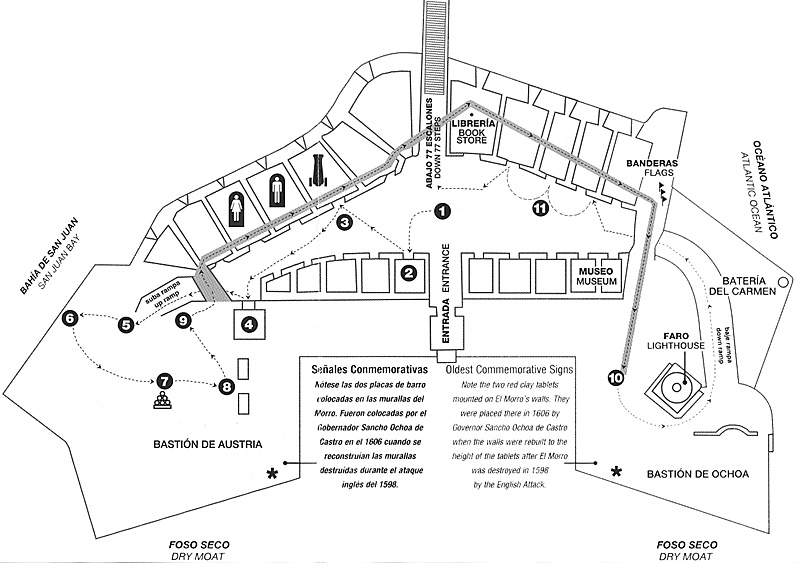Entrance/Upper Level Map

1. Begin your tour in the main plaza. Here troops assembled for parades, inspections, and guard mounts. The well in the center gave access to three underground cisterns which held 220,000 gallons of rainwater collected from El Morro's gundeck surfaces - enough for a year's supply if the garrison were under siege. The vaulted rooms surrounding the plaza are called casemates. They served as living quarters for officers and soldiers, storerooms for food, powder magazines, prison cells, and cannon firing positions.
2. The garrison worshiped twice a day in this chapel. The artwork you see over the altar is a replica of an oil painting by Alejo Fernandez circa 1531, The Virgin of the Navigators. The Archivo General de Indias in Spain has the original work.
3. At least six artillerymen were required to work this 8-pounder cannon, capable of firing an average of two balls per minute. Located 120 feet above sea level, this cannon could fire at ships up to about a half mile away.
4. The powder magazine stored ammunition inside walls built thick enough to be considered bombproof.
5. Go up the ramp to the Austria Bastion. This part of El Morro was completed in 1595 to protect against land approaches.
6. The small fort you see across the bay is Fort San Juan de la Cruz, best known as "El Canuelo". This smaller fort helped ei Morru protect the entrance channel to San Juan Bay. The cannon on the two forts created a deadly crossfire should enemy ships try to sail into the harbor.
7. The mortar shells you see stacked here in pyramid form weigh about 200 pounds each. Black powder was poured in the hollow interior of the ball, and a fuse tapped into the opening. Once loaded inside the barrel, gunners first lit the fuse on the shell, and then the gun. Mortar shells exploded over the heads of enemies.
8. The chimney-like air vents you see here provided fresh air to the rooms below.
9. This mortar has a short barrel compared to its wide diameter. It threw large exploding projectiles at high angles.
10. Three flags fly daily on this Ochoa Bastion: the United States flag, the Puerto Rican flag, and the Spanish military flag, known as the Cross of Burgundy.
The first lighthouse was built in 1846. The present one in 1876, when shellfire from the US Navy damaged it during the Spanish-American War in 1898. The lighthouse you see today was rebuilt in 1908 by American military forces.
11. From the cannon embrasures in this casemates, you may look down on the lower levels of El Morro. The vertical design of this fortress protected the harbor entrance against enemy ships. Across the entrance into the bay, on Cabras Island, are two ruined buildings, all that is left of a leper colony built by the Spanish in 1883.
Castle San Felipe del Morro (El Morro) San Juan, Puerto Rico
- Four Attacks: 1595-1797
El Morro Walking Tour: Main Plaza
El Morro Walking Tour: Bastion de Austria
El Morro Walking Tour: Bastion de Ochoa
El Morro Walking Tour: Battery del Carmen
El Morro Walking Tour: Artillery Ramp
El Morro Walking Tour: Battery de Santa Barbara
El Morro Walking Tour: Garita (Sentry Boxes)
El Morro Walking Tour: Lower Level
El Morro Walking Tour: Promenade (Outside Fort)
El Morro Walking Tour: Map of Upper Levels
El Morro Walking Tour: Map of Lower Levels
Back to List of Historic Sites
Back to Travel Master List
Back to MagWeb Master List of Magazines
© Copyright 2005 by Coalition Web, Inc.
This article appears in MagWeb.com (Magazine Web) on the Internet World Wide Web.
Other articles covering military history and related topics are available at http://www.magweb.com